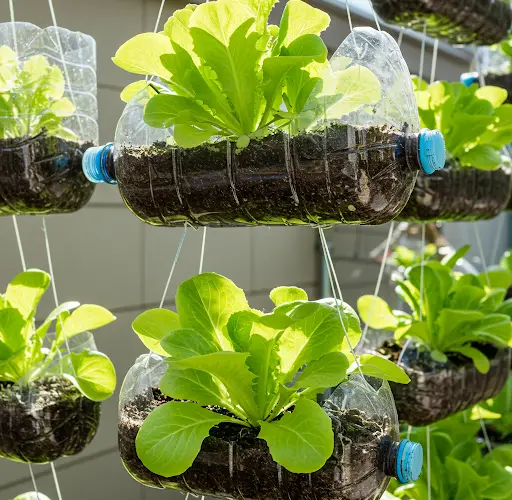Grow Hanging Lettuce in Reused Bottles – A Space-Saving Garden Solution
Lettuce is one of the easiest and most rewarding leafy greens to grow at home. It’s fast-growing, nutritious, and can be harvested multiple times. However, if you’re working with limited space—like a balcony, small patio, or windowsill garden—traditional planting methods might not be practical.
That’s where the idea of growing lettuce in hanging plastic bottles comes in. This method reuses everyday plastic waste to create vertical gardens that are not only eco-friendly but also highly space-efficient. Whether you’re a seasoned gardener or a beginner, this clever DIY approach lets you enjoy a fresh supply of homegrown lettuce with minimal effort and zero need for garden beds.
Why Use Hanging Bottles for Growing Lettuce?
Growing lettuce in hanging bottles offers several benefits:
-
Space-saving: Perfect for small apartments or urban settings.
-
Low-cost: Reuses plastic bottles you already have.
-
Sustainable: Reduces plastic waste and promotes eco-conscious gardening.
-
Aesthetic: Creates a lush, green wall that also produces food.
This method works best for small, leafy vegetable varieties like loose-leaf, romaine, or butterhead lettuce.
Materials You’ll Need
To get started, gather the following materials:
-
1.5 or 2-liter plastic bottles (as many as you want to plant)
-
Scissors or a utility knife
-
A nail or hot metal rod (for drainage holes)
-
Strong string, wire, or rope for hanging
-
Potting soil or a lightweight growing mix
-
Lettuce seeds (preferably loose-leaf varieties)
-
Water spray bottle or watering can
-
A sunny wall, balcony, or fence
Step-by-Step Guide to Making Hanging Bottle Planters
1. Prepare the Bottles
-
Rinse and clean each plastic bottle thoroughly.
-
Cut a rectangular hole on one side of the bottle, about 4–5 inches long and 2 inches wide. This will be the planting area.
-
Poke 4–5 small holes in the bottom of the bottle for drainage.
-
If hanging vertically (neck down), you can cut off the bottle’s base and use the neck for slow drainage.
2. Add Hanging Mechanism
-
Make two small holes near the cut opening (one on each side of the bottle).
-
Thread wire or rope through the holes to create a hanging loop.
-
If you prefer, create a horizontal “ladder” system by tying several bottles to a wooden or metal frame.
3. Fill with Soil
-
Add a lightweight potting mix enriched with compost or organic matter.
-
Leave about an inch of space from the top to allow easy watering.
4. Sow the Seeds
-
Scatter 5–10 lettuce seeds evenly in the soil of each bottle.
-
Cover them lightly with a thin layer of soil or just press them gently into the surface.
-
Water gently using a spray bottle to moisten the soil without disturbing the seeds.
Caring for Your Hanging Lettuce
Sunlight:
Place the hanging bottles where they’ll receive 4–6 hours of sunlight daily. Lettuce prefers cooler temperatures, so morning or filtered light is ideal in hot climates.
Watering:
Water regularly to keep the soil moist, but not soggy. The bottles should have good drainage to prevent root rot. Hanging planters dry out faster than ground beds, so check soil moisture often.
Feeding:
Lettuce grows fast and can benefit from light feeding. Use a diluted organic liquid fertilizer like seaweed extract or compost tea every 10–14 days.
Thinning:
Once seedlings are about 2 inches tall, thin them by removing weaker plants, leaving 3–5 healthy seedlings per bottle. This gives them space to grow full and lush.
Harvesting Your Lettuce
Most lettuce varieties are ready to harvest in 30–40 days. You can:
-
Harvest outer leaves as needed (“cut-and-come-again” method), which allows continued growth.
-
Harvest the whole plant if it becomes crowded or starts to bolt (go to seed), especially in warmer months.
Using the cut-and-come-again method gives you weeks of fresh greens from the same bottle.
Creative Hanging Ideas
-
Vertical frame: Attach multiple bottles to a wooden pallet or metal rack.
-
Window railing: Hang bottles from balcony or window railings for easy access.
-
Fence or wall garden: Create a living wall with lettuce growing at different levels.
You can mix in other leafy greens like spinach, mustard greens, or arugula for variety.
Tips for Success
-
Avoid overwatering—plastic bottles can retain too much moisture if drainage is poor.
-
Rotate the bottles every few days if sunlight is uneven.
-
Reuse the same bottles for new crops by refreshing the soil.
-
Choose heat-tolerant lettuce varieties if growing in warmer climates.
Conclusion
Growing lettuce in hanging plastic bottles is an inventive way to garden in small spaces while reusing materials that would otherwise be discarded. It’s practical, affordable, and incredibly rewarding—imagine stepping out onto your balcony and picking fresh lettuce for your sandwich or salad!
With just a few tools and a little creativity, you can turn any sunny wall or railing into a productive mini-farm. Whether you’re a city dweller or a backyard gardener looking to save space, this method brings sustainability and freshness right to your fingertips.



